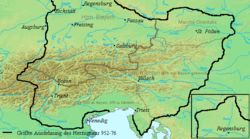- March of Austria
-
March of Austria
Marchia AustriaeState of the Holy Roman Empire ← 
←
976–1156  →
→German map showing the Marcha Orientalis (upper right) along the Danube (Donau), near Sankt Pölten, within the Duchy of Bavaria (10th century) Capital Vienna Language(s) Austro-Bavarian German Religion Roman Catholic Government Monarchy Margrave - 976–994 Leopold I
(first Babenberg margrave)- 1136–41 Leopold IV¹
(last margrave)Historical era Middle Ages - Established 976 - Disestablished 1156 1: Also Dukes of Bavaria from 1139. History of Austria 
This article is part of a seriesEarly History Hallstatt culture Noricum Marcomanni Samo's Realm Carantania March of Austria Babenberger Privilegium Minus Habsburg era House of Habsburg Holy Roman Empire Archduchy of Austria Habsburg Monarchy Austrian Empire German Confederation Austria-Hungary World War I Assassination of Franz Ferdinand World War I Interwar Years German Austria First Republic of Austria Austrofascism/Federal State of Austria Anschluss World War II National Socialism World War II Post-war Austria Allied-occupied Austria Second Austrian Republic
Austria Portal
The March of Austria was created in 976 out of the territory that probably formed the earlier March of Pannonia. It is also called the Margraviate of Austria or the Bavarian Eastern March. In contemporary Latin, it was the marchia Austriae, Austrie marchionibus, or the marcha Orientalis. In modern German, it is usually called the Ostmark, a translation of marchia Orientalis.
The first march covering approximately the territory that would become Austria and Slovenia, was the Avar March established by Charlemagne in the late 8th century against the Avars. When the Avars disappeared in the 820s, they were replaced largely by a Slavic people, who established the state of Great Moravia. The region of Pannonia was set apart from the Duchy of Friuli in 828 and set up as a march against Moravia within the regnum of Bavaria. These marches corresponded to a frontier along the Danube from the Traungau to Szombathely and the Raba river and including the Vienna basin. By the 890s, the Pannonian march seems to have disappeared, along with the threat from Great Moravia.
In 976, during a general restructuring of Bavaria, the Emperor Otto II erected a new march, called, like its Pannonian predecessor, the marcha orientalis. It was not long before the Bavarian eastern march acquired its name of Austria. In 996, the march ruled by the Babenberg family was described as regione vulgari vocabulo Ostarrîchi, that is, "the region commonly called Ostarrîchi." The term Ostarrîchi is linguistic ancestor of the German name for Austria, Österreich.
The early margraviate was populated by a mix of Slavic and native Romano-Germanic peoples who were apparently speaking Rhaeto-Romance languages, remnants of which remain today in parts of northern Italy (Friulian and Ladin) and in Switzerland (Romansh). In the Austrian Alps some valleys retained their Rhaeto-Romance speakers until the 17th century. The early march corresponded closely to the modern region of Lower Austria. Its chief city was Sankt Pölten, though it eventually became Vienna.
The obscurity of the period from circa 900 until 976 leads some to posit that a Pannonian or Austrian march existed against the Magyars, alongside the other marches which were incorporated into Bavaria in 952 (Carniola, Carinthia, Istria, and Verona).[1] However, much of (Lower) Pannonia was now conquered by the Magyars. The Austrian march was raised on the territory which remained in 976. The first margrave, Leopold I, replaced one Burchard, whose status is not well known but may represent a continual margravial authority in the region during the interval 900–976.
The initial Babenberger residence was probably at Pöchlarn, but maybe already Melk, where subsequent rulers resided. The original march coincided with the modern Wachau, but was shortly enlarged eastwards at least as far as the Wienerwald. Under Ernest the Brave (1055–1075), the colonisation of the Waldviertel was begun and the Bohemian and Hungarian marches were united to Austria.
Margravial Austria reached its greatest height under Leopold III, a great friend of the church and founder of abbeys. He patronised towns and developed a great level of territorial independence. In 1139, Leopold IV inherited Bavaria. When his successor, the last margrave, Henry Jasomirgott, was deprived of Bavaria in 1156, Austria was elevated to a duchy independent from Bavaria by the Privilegium Minus of the Emperor Frederick I.
See also
- List of rulers of Austria
- Duchy of Austria
Notes
- ^ Semple, 42.
References
- Semple, Ellen Churchill. "The Barrier Boundary of the Mediterranean Basin and Its Northern Breaches as Factors in History." Annals of the Association of American Geographers, Vol. 5. (1915), pp 27-59.
- Reuter, Timothy. Germany in the Early Middle Ages 800–1056. New York: Longman, 1991.
Categories:- Former monarchies of Europe
- Former countries in Europe
- States of the Holy Roman Empire
- States and territories established in 976
- States and territories disestablished in 1156
- 1156 disestablishments
- Medieval Austria
Wikimedia Foundation. 2010.

